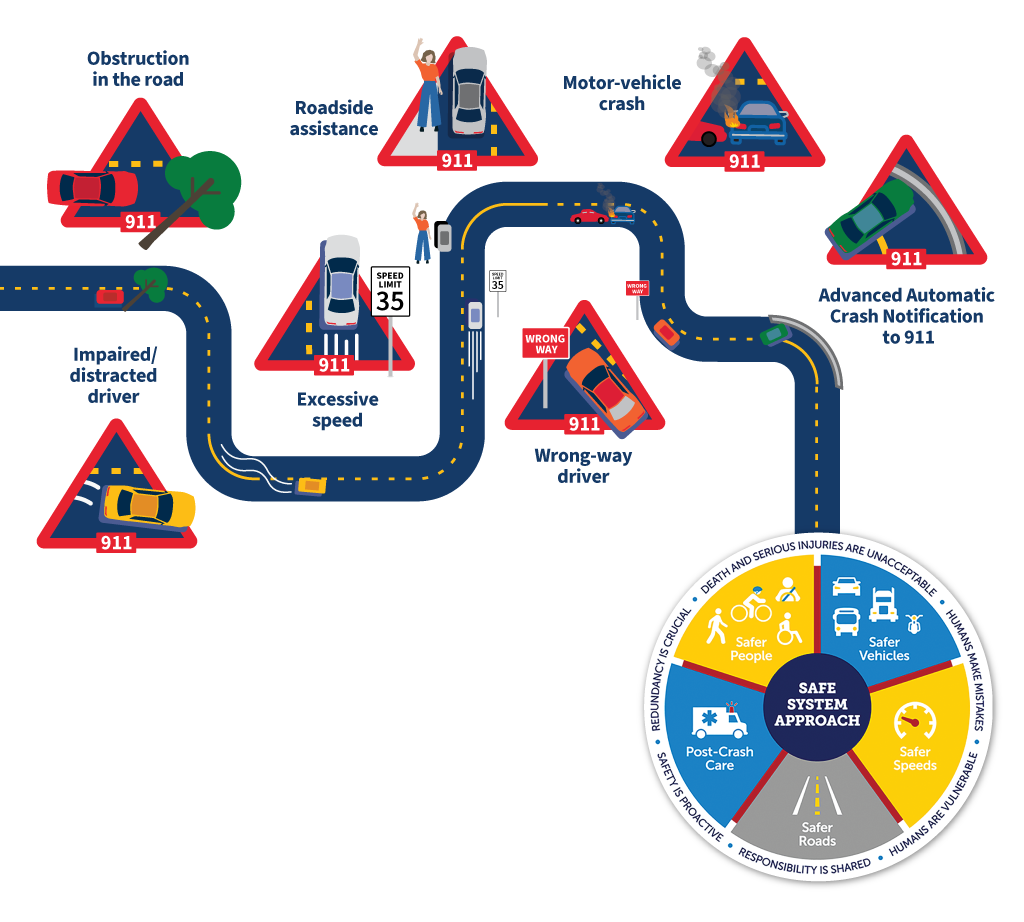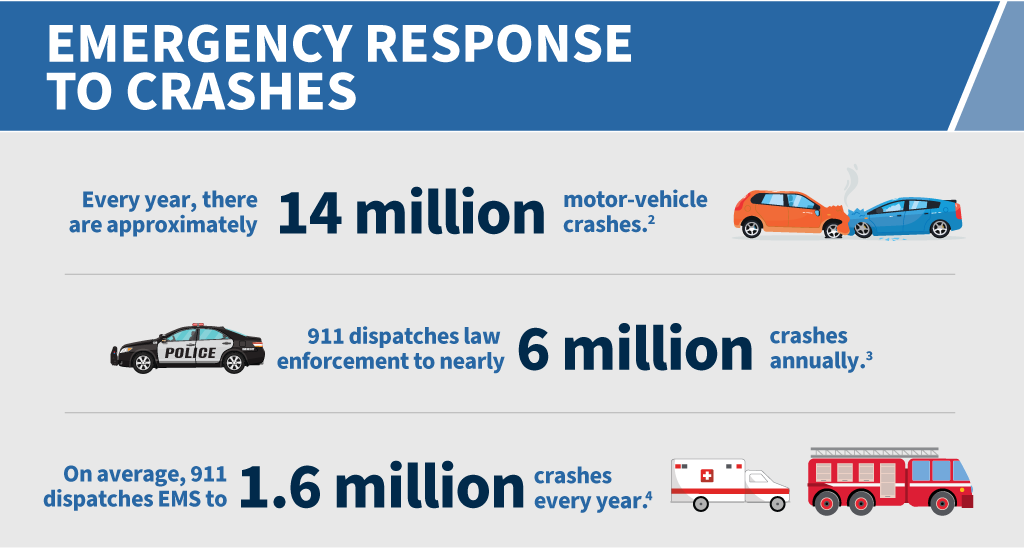911's Role in Highway Safety
911 plays a crucial role in keeping our nation’s roadways safe. Each year, more than 200 million calls are made to 911, and many of them are to report incidents on our highways, roads and streets.
These calls alert 911 centers to a wide range of roadway hazards such as debris, impaired or distracted drivers, excessive speeding, wrong-way vehicles or motor-vehicle crashes.
The Safe System Approach and 911
The National 911 Program is committed to reducing deaths and serious injuries on our roadways through the Safe System Approach. The goal of this framework, outlined in the National Roadway Safety Strategy (NRSS), is to prevent crashes wherever possible and to minimize harm when crashes do occur through post-crash care.
Safer People: When risky behaviors such as impaired, reckless or distracted driving are reported, 911 centers play a vital role by dispatching law enforcement to intervene quickly and prevent potential harm.
Safer Roads: By receiving reports of unsafe roadway conditions—like debris, non-functioning traffic signals or other hazards—911 centers help alert transportation and highway safety authorities to address the danger.
Safer Speeds: 911 centers are an integral part of the enforcement of speed and traffic laws by dispatching and recording law enforcement actions.
Safer Vehicles: Advanced systems such as Automatic Crash Notification (ACN) and Advanced Automatic Crash Notification (AACN) transmit crash data directly to 911 centers, enabling a faster, more informed response through real-time telemetry.
Post-Crash Care: Post-crash care begins the moment a 911 call is received. Telecommunicators must quickly assess the location, nature and severity of the crash and dispatch appropriate resources, laying the foundation for life-saving interventions.
911’s Role in Post-Crash Care
911 plays a vital role in dispatching help to roadway incidents and crashes. Every call to 911 presents the potential for a response by public safety that will result in additional vehicles entering the roadways. And, in emergencies, public safety vehicles may need to proceed at a high rate of speed. The timely and accurate identification of an incident's location and the ability to dispatch the most appropriate resources has a significant impact on the roadways.
Countermeasures: How 911 Can Help Improve Survival
-
Protocols - Structured call-taking protocols and adequately staffed 911 centers with properly trained telecommunicators play a vital role in minimizing the impact of roadway incidents. Protocols ensure the appropriate emergency response is dispatched and may guide telecommunicators in providing instructions to bystanders, enabling life-saving care before responders arrive.
Ultimately, every 911 call impacts highway safety on multiple levels. Call-taking protocols establish response priority, ensuring the safest and most efficient use of emergency resources. Protocols may determine whether or not to dispatch emergency response vehicles (and if so, how many), whether lights and sirens are utilized and when to cancel or divert a response.
Traffic Incident Management - When 911 personnel are trained in Traffic Incident Management (TIM), they learn critical decision-making that may reduce the duration and impact of traffic incidents and decrease the risk of secondary crashes.
-
The specific location of a crash or a highway safety incident matters. GIS data is the foundation for location-based routing of wireless 911 calls. In rural areas, the limitations of callers to specify crossroads, mile markers and other identifiable location markers hampers emergency response.
Accurate and up-to-date addresses, available through the National Address Database (NAD), are critical to transportation safety and are a vital part of Next Generation 911 (NG911). NG911-compliant addressing provides telecommunicators with the exact crash or caller location, minimizing the risk of missed locations and delayed response (which is directly tied to medical outcomes of crash victims).
In suburban areas, location accuracy may be easier to communicate, but the overlap of public safety jurisdictions due to city, town and county lines can impact dispatching decisions. GIS data helps 911 identify the most efficient and appropriate resource so they can dispatch based on exact location.
-
Standardized data collection and collaboration between 911 and highway safety agencies are essential to understanding and preventing crashes. When 911 centers collect consistent data, it provides valuable insights into driving behaviors—such as distraction, impairment and recklessness—and identifies trends like high-frequency crash locations or high-risk intersections and road segments. These insights support targeted interventions by transportation officials and guide funding decisions, training priorities and operational planning across both public safety and the broader transportation system.
Conversely, standardized roadway data from highway safety agencies can enhance 911 operations by improving situational awareness and response efficiency. In short, when 911 and highway safety share complementary data, this creates the foundation for a safer, smarter roadway network.
-
Interoperability—the ability of systems and agencies to share and use information in real time—ensures the right help reaches the right place at the right time. Within 911 centers, interoperability across systems such as Computer-Aided Dispatch (CAD), mapping tools and communication platforms enhances dispatch efficiency and situational awareness. CAD-to-CAD integration takes this a step further by enabling direct information exchange between jurisdictions, ensuring the most appropriate unit is dispatched quickly.
Advanced technologies like Automatic Crash Notification (ACN) further strengthen interoperability by transmitting critical crash details—such as severity and likelihood of injury—directly to 911 centers. These capabilities are estimated to save between 360 and 721 lives annually. For the most effective roadway incident response, 911 centers operate as the hub of coordination between traffic management authorities, departments of transportation, towing services and utilities.
Download ‘911 & Highway Safety’ Infographic
911 and Highway Safety: The Importance of Collaboration
Reducing injury and death on our roads requires collaboration above all else. Because professionals in 911, EMS and highway safety share an interest in making our streets safer, it’s natural that 911 leaders should communicate, cooperate and collaborate to end the crisis of motor-vehicle crash fatalities.
-
Get to know who’s in your State Highway Safety Office (SHSO) and your state EMS official. Both highway safety and EMS are good potential partners to develop projects and programs aimed at improving survivability from a crash.
Read your State Highway Safety Plan to see what’s included and identify programs and projects for possible collaboration. NHTSA has a searchable database of state plans, annual reports and annual grant applications.
Share funding opportunities including local, state and federal grants for highway safety projects.
Share training and educational opportunities about initiatives that impact both 911 and Highway Safety such as Prehospital Blood Transfusion and Traffic Incident Management training.




